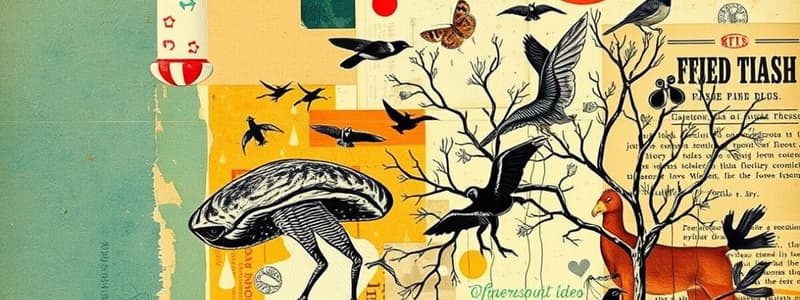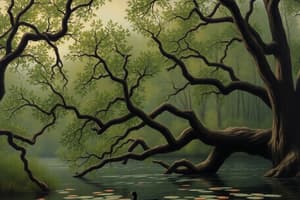Podcast
Questions and Answers
Which biome is characterized by being treeless and the coldest and harshest on Earth?
Which biome is characterized by being treeless and the coldest and harshest on Earth?
- Temperate Deciduous Forest
- Taiga Boreal Forest
- Tropical Rainforest
- Tundra (correct)
What process converts ammonia to nitrite and then to nitrate?
What process converts ammonia to nitrite and then to nitrate?
- Nitrification (correct)
- Eutrophication
- Denitrification
- Nitrogen fixation
Which biome is known for its wet and dry seasons?
Which biome is known for its wet and dry seasons?
- Tundra
- Savanna (correct)
- Aquatic Biome
- Temperate Grassland
Which of the following is NOT a characteristic of the aquatic biome?
Which of the following is NOT a characteristic of the aquatic biome?
What is a significant ecological consequence of eutrophication?
What is a significant ecological consequence of eutrophication?
What type of rain is created when sulfur dioxide and nitrogen oxides react with water in the atmosphere?
What type of rain is created when sulfur dioxide and nitrogen oxides react with water in the atmosphere?
Which of the following is true about the long-term carbon cycle?
Which of the following is true about the long-term carbon cycle?
What type of forest biome has coniferous trees and nutrient-poor soil?
What type of forest biome has coniferous trees and nutrient-poor soil?
Which of the following describes the role of nitrogen-fixing bacteria in ecosystems?
Which of the following describes the role of nitrogen-fixing bacteria in ecosystems?
What do food webs illustrate compared to food chains?
What do food webs illustrate compared to food chains?
What is typically located at the first trophic level in a food chain or web?
What is typically located at the first trophic level in a food chain or web?
What percentage of energy is typically transferred from one trophic level to the next?
What percentage of energy is typically transferred from one trophic level to the next?
Which term describes the organisms that capture and eat other organisms?
Which term describes the organisms that capture and eat other organisms?
How do herbivores affect energy flow in a food chain?
How do herbivores affect energy flow in a food chain?
What role does predation play in ecosystems?
What role does predation play in ecosystems?
What happens to energy as it moves up trophic levels in a food chain?
What happens to energy as it moves up trophic levels in a food chain?
What is coevolution primarily a result of?
What is coevolution primarily a result of?
Which of the following adaptations helps prey avoid capture?
Which of the following adaptations helps prey avoid capture?
What defines carrying capacity in an ecosystem?
What defines carrying capacity in an ecosystem?
In which type of dispersion do organisms evenly spread out to compete for resources?
In which type of dispersion do organisms evenly spread out to compete for resources?
What is the first stage of ecological succession after a severe environmental disturbance?
What is the first stage of ecological succession after a severe environmental disturbance?
Which mimicry type involves a harmless species mimicking a harmful one?
Which mimicry type involves a harmless species mimicking a harmful one?
What kind of relationship is created when both organisms benefit?
What kind of relationship is created when both organisms benefit?
What primarily drives migration in populations?
What primarily drives migration in populations?
Which biome is characterized by low precipitation and extreme temperatures?
Which biome is characterized by low precipitation and extreme temperatures?
Flashcards are hidden until you start studying
Study Notes
Energy Flow and Trophic Levels
- Food chains illustrate a linear pathway of energy transfer between organisms in an ecosystem.
- Food webs showcase a complex network of interactions, representing multiple food chains.
- Producers (first trophic level) generate their own food; primary consumers (herbivores) eat producers.
- Secondary, tertiary, and quaternary consumers include carnivores and omnivores feeding on other consumers.
- Energy flow through trophic levels is typically upward and is generally inefficient; only about 10% of energy is transferred to the next level.
Predator-Prey Dynamics
- Predators capture and consume prey; predation significantly influences prey populations.
- Coevolution occurs as predators and prey adapt in response to each other over time.
- Camouflage, chemical defenses, and mimicry (Batesian and Müllerian) are common adaptations for avoiding predation.
Symbiosis and Interactions
- Symbiosis involves relationships between different organisms, which can be mutualistic, commensal, or parasitic.
- Mutualism benefits both species, commensalism benefits one without harming the other, and parasitism benefits one while harming the other.
- Ectosymbiosis (living on another organism) and endosymbiosis (living inside another organism) are variants of symbiotic relationships.
Carrying Capacity and Population Dynamics
- Carrying capacity refers to the maximum population size that an ecosystem can sustain based on resource availability.
- Population growth is exponential until it reaches carrying capacity, after which it stabilizes.
- Dispersion patterns describe how individuals spread within an area: uniform, clumped, or random based on resource distribution.
Ecological Succession
- Primary succession occurs after catastrophic events that destroy soil; it takes a long time to establish a community.
- Secondary succession happens after disturbances like fires or floods that leave soil intact and allows quicker regrowth.
- Pioneer species first colonize disturbed areas, gradually leading to increased biodiversity and eventual climax communities.
Biomes Classification
- Biomes are large ecological areas defined by climate, soil, plants, and animals.
- Major biomes include grasslands (savannas and temperate), deserts (hot and dry, semi-arid), forests (deciduous, tropical, taiga), aquatic biomes (freshwater and marine), and tundras (polar deserts with permafrost).
- Each biome exhibits unique adaptations and biodiversity that reflect environmental conditions.
Nitrogen Cycle and Eutrophication
- Nitrogen fixation transforms atmospheric nitrogen into ammonia for plant use, facilitated primarily by nitrogen-fixing bacteria.
- Nitrification processes turn ammonia into nitrite and then nitrate, both accessible to plants.
- Eutrophication, caused by excess nutrient input (from fertilizers or sewage), leads to harmful algae blooms that deplete oxygen and disrupt aquatic ecosystems.
Carbon Cycle Dynamics
- Carbon is essential for energy storage, with plants converting CO2 into carbohydrates via photosynthesis.
- Cellular respiration returns CO2 to the atmosphere, maintaining a continuous cycle, although some carbon sequesters for long periods in organic material or coral structures.
Energy Conservation and Types
- Energy is the capacity to do work and can be kinetic (in motion) or potential (stored).
- Important energy forms include thermal, electric, and nuclear.
- Energy is conserved in transformations, rarely lost entirely but dissipated as heat.
Energy Sources
- Energy sources include non-renewable (coal, oil, natural gas) and renewable (wind, solar, hydroelectric).
- Non-renewable resources are finite and formed over millions of years, while renewable resources can be quickly replenished and utilized sustainably.
Fossil Fuels and Environmental Impact
- Fossil fuels are derived from ancient organic materials, with coal, oil, and natural gas being the primary forms.
- All fossil fuels generate greenhouse gases that contribute to global warming and environmental degradation when burned.
- New technologies aim to make fossil fuel use less harmful through methods like coal washing, flue gas desulfurization, and carbon capture and storage.
Clean Coal Technologies
- Technologies such as coal washing and low-NOx burners help reduce coal's environmental impact by removing impurities and minimizing harmful emissions.
- Carbon capture and storage (CCS) mitigates atmospheric CO2 by capturing it before it is released.
Studying That Suits You
Use AI to generate personalized quizzes and flashcards to suit your learning preferences.




